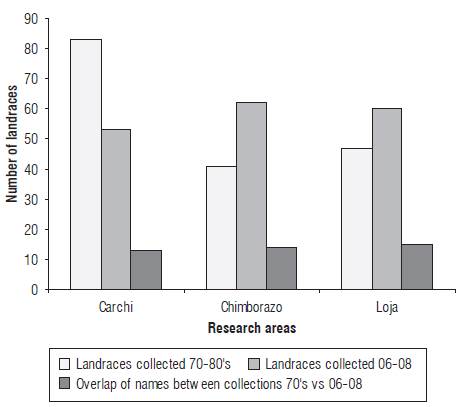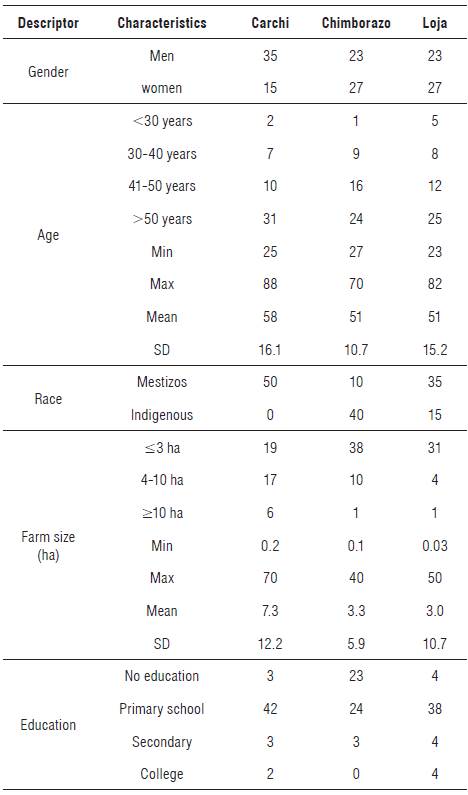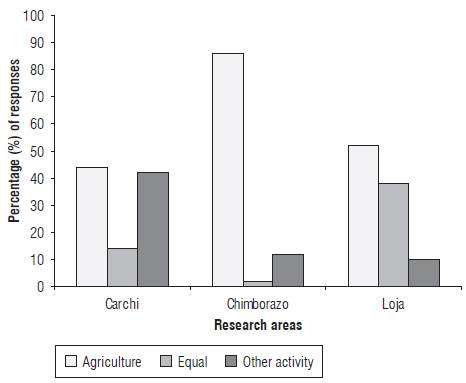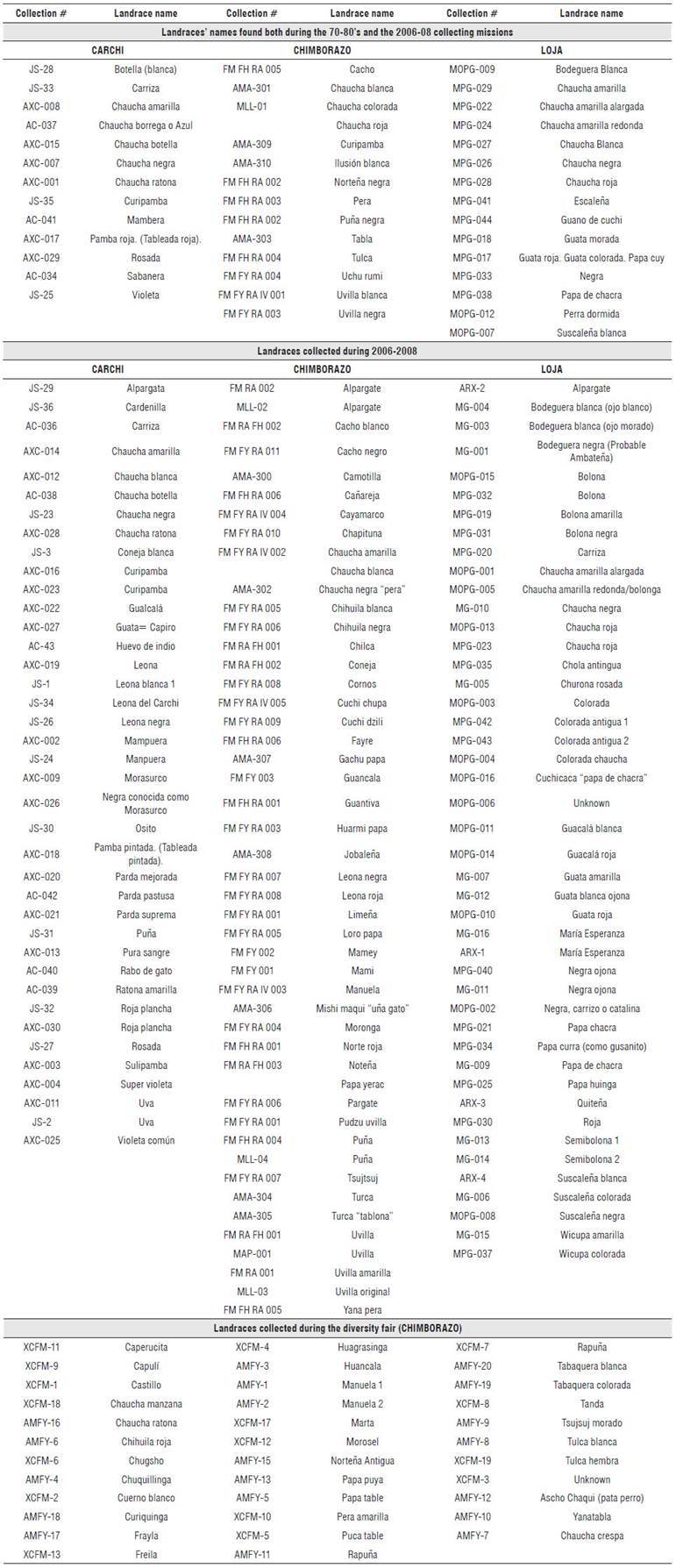Introduction
In South America, there is wide diversity in cultivated and wild potato species. Ecuador is one of the centers of diversity for these species (Hawkes, 1988; Hawkes, 1990). The Ecuadorian biodiversity of potato includes 23 wild species and three cultivated Solanum tuberosum (Andigenum group) diploids, triploids and tetraploids (Spooner et al., 1992; Spooner et al., 2007; Spooner et al., 2014). The diversity in cultivated potato is not randomly distributed; spots with high diversity can be identified. These spots or microcenters are small areas in which the diversity of a crop is concentrated (Harlan, 1951). The International Potato Center (CIP) has identified some microcenters of diversity for native potatoes. In Ecuador, the Chimborazo and Carchi provinces are considered such microcenters (CIP, 2017). Areas with high diversity are suitable targets for on-farm conservation of plant genetic resources (Bellon, 2004). On-farm conservation studies on native potatoes have been published in Peru (Brush and Taylor, 1992; Brush et al., 1995; De Haan et al., 2007; De Haan and Juárez, 2010; De Haan et al., 2010) and Bolivia (Terrazas et al., 2005; Terrazas and Cadima, 2008; Iriarte et al., 2009). Initial studies on native potatoes in Ecuador were carried out by Monteros et al. (2005a), but more studies are required in order to achieve efficient in situ conservation of these valuable resources in this country.
Two research sites identified in the study by Monteros et al. (2005a) (Carchi and Chimborazo) are identical to the microcenters identified by CIP (2017). The province of Loja was identified as the third research site; this province was recognized as a biodiversity hot spot (Pohle and Gerique, 2008b), but its potato diversity has not been recognized yet. The ethnic background of the farmers who cultivate these potatoes is different in the three research areas.
Most of the population in Carchi is "mestiza", people with a mixed Spanish and Indigenous cultural background. According to Frolich et al. (1999) and Espinosa (2006), they were never under Inca influence. Carchi has a relatively small number of indigenous people, 2.8% of the total population in the province according to Chisaguano (2006). Carchi is also the first area where intensive potato monocropping became a common practice during the last 20-30 years. However, this area has changed, currently almost exclusively producing pasture and milk cow grazing (Frolich et al., 1999). Espinosa (2006) highlighted the lack of organization and cooperation among farmers in Carchi.
In Chimborazo, most of the farmers are indigenous people who value their culture (Espinosa, 2006). Chimborazo is considered the capital of the indigenous population, accounting for 38% of the total population in the province (Chisaguano, 2006). From the 17th century on, Chim-borazo's countryside has been dominated by the "hacienda" system; the system was based servitude known as "Huasipungo" (Korovkin, 1997). In 1964, these farmers were granted property rights for their small plots of land (Korovkin, 1997). Farmer organization tends to be stronger here than in Carchi (Espinosa, 2006).
Loja, in southern Ecuador, has an indigenous population of about 3.1%, mostly located in the Saraguro canton (Chisaguano, 2006). Saraguro is one of the areas within the Loja province with a higher level of potato crop diversity (Finerman and Sacket, 2003; Pohle and Gerique, 2008b). The Saraguros are a highland Indigenous group who speak Quichua. Since the 19th century, they have kept cattle to supplement their traditional "system of mixed cultivation", featuring maize, beans, potatoes and other tubers. It is assumed that they originally came from the Titicaca region in Bolivia and settled as workers and vassals in the Andean highlands, working for the Incas (Pohle, 2008a). Nowadays, mestizos and indigenous people share the region.
In this study, we used the term landrace as defined by Camacho et al. (2006): "A landrace is a dynamic population(s) of a cultivated plant that has historical origin, distinct identity and lacks formal crop improvement. It is also genetically diverse, locally adapted and associated with traditional farming systems". More than 400 landraces of native potatoes have been reported in Ecuador (Cuesta et al., 2005). However, only 20 landraces have been reported to be marketed in the central provinces of Ecuador (Unda et al., 2005). In addition, it is unknown to what extent farmers maintain landraces in the Ecuadorian Andes although it has been suggested that the introduction and use of modern cultivars and the lack of market opportunities are negatively influencing the conservation of landraces (Cuesta et al., 2005). However, there is no systematic inventory on the forces that benefit the conservation of these materials.
This paper describes the state of the conservation of potato landraces in Ecuador. The potato diversity found from 2006 to 2008 at three locations was compared with the diversity at the same places approximately 30 years ago to determine the dynamics in the potato diversity. Potato farmers currently growing landraces were interviewed and invited to local meetings to evaluate the vulnerability of the contemporary system.
Materials and methods
The research areas
To identify the research areas, three databases with the passport data of previous collections in Ecuador from the 1970s and 1980s were used. The data were analyzed with the program DIVA GIS 4.2 (Hijmans et al., 2004). One database was obtained from the International Potato Center (CIP), which contained 459 Ecuadorian accessions, including cultivated and wild species (CIP, 2007); the two remaining databases were obtained from The National Institute for Agricultural Research INIAP (Instituto Nacional de Investigaciones Agropecuarias). The INIAP databases were from the National Program for Root and Tuber Crops-PNRT (692 accessions of cultivated material) and from the National Department of Plant Genetic Resources-DENAREF (187 accessions of cultivated and wild material). Duplicates in the databases were eliminated. These duplicates were determined by identical names and collection sites between the databases; the same was done for the landraces or wild materials. Accessions corresponding to modern cultivars were also eliminated. In addition, landraces with identical names at the canton level were eliminated because the authors assumed they were the same material. In total, 443 accessions of landraces were included in the new database.
Three research sites were selected. DIVA GIS 7.5 generated maps with colored cells indicating the number of landraces present (Fig. 1), which were used as the first selection criterion. Since there were several areas with high numbers of landraces, the geographical location (north, center and south) was considered as well. The three research sites that were selected were located in the provinces of Carchi, Chimborazo, and Loja (Fig. 1).

FIGURE 1 Distribution of cultivated native potatoes in the Andean region of Ecuador using DIVA GIS 7.5 (passport data from collections during the 1970s and 1980s). A) Potato landraces distribution in Ecuador. The research areas selected for this study included: B) Province of Carchi (north of the country), C) Province of Chimborazo (central part of the country) and D) Province of Loja (south of the country).
Collection of the landraces in the research areas
The earlier potato collection missions in the 1970s and 1980s yielded over 400 accessions of Ecuadorian potato landraces. These samples included 82 accessions from Carchi, 35 from Chimborazo and 41 from Loja. However, over the years, accessions were lost and only 91 Ecuadorian potato landraces were still maintained ex situ at the time the first collection activities for this study were performed in 2006.
As done in the earlier collections, we explored the cantons Espejo, Mira, El Angel, Huaca, Montufar, San Gabriel and Tulcan in Carchi; Chunchi, Colta, Guamote, Guano, Penipe and Riobamba in Chimborazo (the canton Alausi was included in this collection, but not in the 1970s-1980s collection), and Gonzanama, Loja and Saraguro in Loja. The collections followed the methodology currently used by INIAP and other gene banks (Castillo and Herman, 1995). The farmers were informed of the purpose of this study and they agreed to provide the materials to the collectors. As there was no information on the individual farmers that were visited in the collection missions in the 1970s and 1980s, information was gathered in every mi-crocenter for farmers holding "old potato landraces", with the assumption that this snowball technique would deliver some information about the current holders of landraces. The search of landraces was not restricted to those already reported, but for all available old landraces. After collecting a specific landrace, any other landrace with the same name from another farmer in the same canton was discarded. Landraces were only collected when the morphological appearance was (slightly) different from the synonym landrace. Every collection was a sample of five to ten tubers. After every collection trip, the potato samples were taken to the INIAP-Santa Catalina Experimental Station in Quito for propagation and evaluation.
Survey
To collect information about on-farm potato conservation in the three research areas, a questionnaire with 32 questions was prepared (Appendix 1). Fifty (50) farmers were selected in each research area. Initially, all farmers that provided germplasm were interviewed. Then, these farmers were asked to suggest other potato farmers in the area that were currently growing potato landraces or had been growing them in the past. This way, the number of farmers needed to meet the required total of 50 farmers per research area was achieved. At the selected farms, the interviews were done with either men or women, based on availability. This fieldwork was carried out from March to August of 2008.
Farmer meetings
Three one-day long farmer meetings were organized in each research area: one in Tenta-Loja (November, 2009), another in San Gabriel-Carchi (December, 2009), and the last one in Pisicaz-Chimborazo (February, 2010). These meetings had three objectives: 1. to provide farmers with feedback from the surveys, 2. to clarify some of the issues that arose from the interviews, 3. to return landraces collected in each study area to the farmers. All of the farmers involved in the collection and survey processes were invited.
Results and discussion
The collecting missions
The snowball technique used to find farmers conserving potato landraces was effective. The farmers in each location pointed out other farmers with specific landraces. After scanning all of the potential farmers in the areas with landraces, except in Chimborazo where more farmers had landraces in their fields, different landraces were traced for collection. During the first trip to Carchi, 14 accessions of potato landraces were collected in the Montufar canton. A second trip later that year added another 38 landraces. For Chimborazo, INIAP-CIP conducted a collection mission in early 2006 to two cantons: Colta and Guamote. At that time, 46 landraces were collected. A complementary collection carried out in 2008 in other cantons (Guano, Penipe, Rio-bamba, Alausi and Chunchi) resulted in 16 new landraces. In Loja, during January of 2008, 60 potato landraces were collected. A total of 174 landrace accessions were collected from 17, 28 and 30 farmers in Carchi, Chimborazo and Loja, respectively. Farmers growing potato landraces were scarcer in Carchi and dispersed in Loja (and consequently more difficult to find), while in Chimborazo most of the farmers (including the indigenous communities) kept old landraces in their fields.
Additionally, one diversity fair was organized in Chimborazo (Colta canton) in 2008 (Project INNOVANDES, CIP-INIAP-FAO) to celebrate the International Year of the Potato. This fair, which aimed to create awareness and bring potato growers together to exchange material, resulted in 35 additional landraces based on names, morphological characteristics and origin.
All these potato landraces were integrated into the potato collection at the Ecuadorian genebank at INIAP (Appendix 2). In total, this collection provided 209 accessions of landraces from the research areas. They constitute almost 50% of the newly assembled Ecuadorian potato collection, comprising about 450 accessions.
Figure 2 shows the number of landraces collected at each microcenter, based on their names. The names of the land-races collected during the 1970s and 1980s were compared with those collected in the present study (Fig. 2, Appendix 2), and only 13 names were similar between the 2 collection periods for the Carchi research area. In Chimborazo and Loja, only 14 and 15 names were similar, respectively.
Characteristics of the interviewed farmers
The characteristics of the interviewed farmers are shown in Table 1. Men and women growing potato landraces were interviewed according to their availability, which resulted in fairly equal representation in Chimborazo and Loja. Only the survey in Carchi had over-representation by men. However, the men category included six cases in which husbands and wives answered the questions together, but the women preferred their husbands' names to be included in the survey format. According to Table 1, most of the farmers were over the age of 50, with an average age of 53. The race distribution (mestizos and indigenous) differed between the regions. The data in Table 1 also showed that the farmers with landholdings of less than 3 ha (19 farmers in Carchi, 38 in Chimborazo and 31 in Loja) were mainly growing potato landraces. The level of education of the respondents was generally poor. The statistical test (Pearson correlation, two tailed) showed hardly any significant correlations between the descriptors. The only low correlation was between age and education (-0.319). The older people were less educated than the younger generations.
In addition to cropping activities, 46% of the farmers in Carchi, 10% in Chimborazo and 64% in Loja kept livestock (cattle and minor animals), or performed house-keeping activities. Other off-farm income-generating activities included paid labor in agriculture or non-agricultural activities, as stated by 20% of the farmers in Carchi, 14% in Chimborazo and 35% in Loja. Figure 3 shows how the farmers valued their activities based on income generation. In Chimborazo, agriculture was the most important activity (86%), whereas in the other regions, the other activities (such as construction or other paid labor) played an important role as well. Most of the potato farmers mentioned having one or more family members who migrated to find a job outside agriculture (53% Carchi, 64% Chimborazo and 52% in Loja).
Potatoes in the farming system
The farmers rotated potatoes with other crops. In Carchi, an individual farm can produce up to five different crops, including potatoes, as seen in Chimborazo with 8 crops and Loja with 7 crops. In total, besides potato, 16 crops or crop groups were mentioned: wheat (Triticum aestivum), barley (Hordeum vulgare), grass (various), faba bean (Vicia faba), carrot (Daucus carota), peas (Pisum sativum), maize (Zea mays), other vegetables (various), ulluco (Ullucus tuberosus), mashua (Tropaeolum tuberosum), oca (Oxalis tuberosa), chocho (Lupinus mutabilis), fruits (various), quinoa (Chenopodium quinoa), bean (Phaseolus vulgaris) and other minor crops. In Carchi, the potato farmers included rotations with all of the crops mentioned above except oca, chocho, fruits, quinoa and beans. In Chimborazo, beans were not considered for rotation because this is a crop more suitable at lower altitudes. In Loja, chocho and quinoa were missing from the potato rotations. The questionnaires addressed only the number of major crops that were present in the rotation with potatoes and not all crops present, e.g. medicinal plants or diversity within the other crops were not surveyed.
Most of the farmers in the research areas grew both land-races and commercial cultivars and managed these groups similarly (64% in Carchi, 58% in Chimborazo and 60% in Loja). However, the landraces were grown in smaller plots or in-home gardens, whereas the commercial cultivars were grown in larger plots (field observation). Some farmers grew early sprouting potatoes (S. tuberosum andigena group, mainly diploids), referred to as "chauchas", along with other triploids and tetraploids in the same fields, but preferred to grow the landraces in separate rows.
After harvest, the commercial cultivars were sold immediately, and the landraces, which are not usually sold in the market, were stored for consumption (in the kitchen or a nearby storage room), distributed among the family, exchanged with the neighbors or saved as seeds for the next cycle. The farmers in Carchi mentioned exchanging seeds in 46% of the cases, with 23% in Chimborazo and 60% in Loja. However, the farmers usually did not know who else in the community maintained the less common landraces (Carchi 75%, Chimborazo 68% and Loja 53%).
Labor allocation
In the potato farming system in Ecuador, there is a division of labor among family members. The different activities in the potato growing cycle and the different labor divisions are summarized in Table 2.
TABLE 2 Labor division during the potato planting cycle by percentage in the three research areas of potato diversity in Ecuador: land preparation, daily cropping activities and harvest.
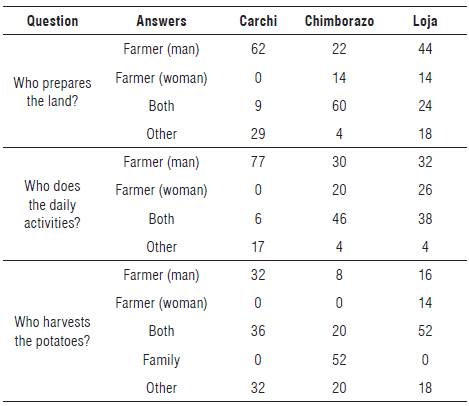
The labor allocation for land preparation was different among the research areas. In Carchi, the men (62%) mainly carried out soil preparation. In Chimborazo, this activity was shared by men and women (60%), and, in Loja, 44% of the respondents answered that only the men prepare the land, but in 24% of the cases, both men and women carried out this activity together. The potato cropping activities (daily activities after planting and before harvesting) were mainly taken care of by the men (77%) in Carchi. This was different in Chimborazo where 46% answered that the activity was shared by men and women. In Loja, 38% answered that men and women together took care of the daily activities, with 32% for only men and 26% for only women. The harvest was, in most cases, a family activity performed by men and women together, as pointed out by the respondents in Chimborazo.
Reasons to maintain potato landraces
Since most potato landraces were not marketed, the farmers grew these potatoes for other reasons. During the meetings, the farmers mentioned culinary characteristics such as good taste and softness after cooking. In Chimborazo, some of the landraces are reported as good for "Cariucho", which is a typical dish with indigenous farmers, made from faba bean, oca, melloco and potatoes boiled together. Other advantageous characteristics include: drought, frost and late blight resistance. Medicinal uses of certain landraces were also mentioned, such as the use of Puña to cure headaches or Chaucha amarilla to cure arthritis. These and other attributes have kept these potatoes from disappearing.
Potato landraces in farmer's fields
Both the collections during the 1970s and 1980s and these collections (2006-2008) managed to gather a significant number of accessions (158 and 174, respectively). Apparently, the farmers have continued to maintain local landraces. When the earlier collections were compared to the results of later collection trips, many new landraces were found based on the recorded names. There was only a small name overlap between the materials collected in both periods (Fig. 2). This emergence of new landrace names is remarkable and contrasts with the general trend of landraces disappearing and diversity decreasing. However, in Carchi, a decrease of landraces from the past to the present was observed, suggesting genetic erosion. The low number of landraces common to the past and present collections may indicate that the sampling of local landraces was far from exhaustive, both during the 1970s and 1980s and during the reported collection trips. This is further supported by the fact that the diversity fair in Chimborazo resulted in many new landraces. Monteros-Altamirano et al. (2017) applied SSR markers to most of the accessions collected in this study, finding significant genetic diversity in the three areas.
A change in the landraces being grown could be explained by the exchange of landraces among farmers, with the associated name changes. Exchanging potatoes is very common in the Andes (Brush et al., 1981; Zimmerer, 1991). However, information does not necessarily travel with the seed lot, producing name inconsistencies (Nuijten and Almekinders, 2008). The movement of potato seed lots may either be inter-regional or intra-regional. The fact that some farmers did not know where the rare landraces were or who in the community held them suggests that this movement has been mainly conducted on an individual basis and not in any organized way. Again, the results presented by Monteros-Altamirano et al. (2017) suggested the exchange of potato landraces among the three areas; nevertheless, each area maintained genetic differentiation from the others.
Who maintains the diversity?
This study shows that the majority of the farmers growing native potatoes were relatively old (Tab. 1). This was similar in all three research areas. This group might be expected to be more knowledgeable on potato landraces than younger farmers. With the current educational system, younger generations become better qualified and eventually migrate to cities looking for more rewarding jobs and leaving behind agriculture, these potatoes and their ancestral knowledge. The farmers conserving the potato landraces had mainly small farms (Tab. 1) and were generally associated with low incomes and even poverty. These small farmers maintained the local landraces for food security and/or cultural heritage, but there were no market opportunities.
Potato production in Ecuador is an activity that is shared between men and women. Men carry out the land preparation - which is very intensive labor when done using animals or hand tools - and fungicide application, if any. Women participate in most of the potato cropping activities. In addition, the harvest is an activity performed by both men and women and a family task in Chimborazo. Family involvement in potato cropping is probably advantageous to the conservation of potatoes. However, migration, especially by men, accounts for the feminization of agriculture as observed by Lastarria-Cornhiel (2006).
How and why are the farmers maintaining the potato diversity?
In Ecuador, cultivated potatoes are part of the broader crop diversity seen in farmers' fields and an important element in crop rotation. Potato landraces coexist with commercial potatoes, as is the case in Peru (Brush et al., 1995). The fact that potatoes and other crops co-exist on farms, again as seen in Peru (De Haan and Juárez 2010; De Haan et al., 2010), indirectly supports the survival of potato landraces. The income from marketable crops (potatoes or others) subsidizes the maintenance of non-commercial potato landraces. In addition, it can be inferred that the income from activities outside the farms is important to the families currently maintaining potato diversity (Fig. 3).
Farmers empirically know the nutritional or medicinal value of their potatoes and, so, maintain landraces from generation to generation as a cultural heritage.
Conclusions
Carchi was the most vulnerable area for the conservation of potato landraces. Frolich et al. (1999) stated that ancient landraces are no longer found in this area. The farmers holding landraces were scattered throughout the province, i.e. not organized. Mostly elderly people maintained the landraces, and the new generation demonstrated a lack of interest in cropping potato landraces. The potato conservation in Chimborazo appeared more sustainable than in the other areas. Even though old people were currently in charge of the potato landraces, the farmers saw agriculture as the most important source of income. The number of indigenous farmers keeping potato landraces in their fields was higher in this province than in the other areas. Apparently, they were more culturally attached to their land and viewed agriculture as a family activity (Tab. 2). The farmers in Loja have conserved potatoes for a long time, but some aspects could make conservation vulnerable. Similar to Carchi, the farmers holding landraces were scattered throughout the province, i.e. not organized, with conservation mainly done on an individual basis.
Externally driven on-farm conservation activities, such as the diversity fair or re-introduction of landraces, were highly appreciated by the farmers. The diversity fair organized in Chimborazo was effective at raising local awareness on the richness of local crop genetic diversity, as observed in other cases (Almekinders, 2001), and promoting landrace exchanges between farmers. Diversity fairs should be organized in the other areas to support on-farm conservation. The creation of communal potato conservation gardens would also help make landraces more available to farmers and raise local awareness. The newly assembled potato collection at INIAP will complement the ex situ - on-farm conservation activities at the national level. Finally, the younger generation of farmers should be motivated to maintain local landraces through education in agrobiodiversity (INIAP-DENAREF, 2009). The creation of market opportunities for the landraces would support both their conservation and use (Monteros et al., 2005b; Devaux et al., 2009).













